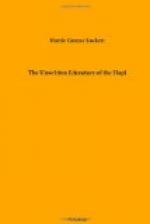This area was once known as the old Spanish Province of Tusayan, and the Hopi villages are called pueblos, Spanish for towns. In 1882, 2,472,320 acres of land were set aside from the public domain as the Hopi Indian Reservation. At present the Hopi area is included within the greater Navajo Reservation and administered by a branch of the latter Indian agency.
The name Hopi or Hopitah means “peaceful people,” and the name Moqui, sometimes applied to them by unfriendly Navajo neighbors, is really a Zuni word meaning “dead,” a term of derision. Naturally the Hopi do not like being called Moqui, though no open resentment is ever shown. Early fiction and even some early scientific reports used the term Moqui instead of Hopi.
Admirers have called these peaceful pueblo dwellers “The Quaker People,” but that is a misnomer for these sturdy brown heathen who have never asked or needed either government aid or government protection, have a creditable record of defensive warfare during early historic times and running back into their traditional history, and have also some accounts of civil strife.
The nomadic Utes, Piutes, Apaches, and Navajos for years raided the fields and flocks of this industrious, prosperous, sedentary people; in fact, the famous Navajo blanket weavers got the art of weaving and their first stock of sheep through stealing Hopi women and Hopi sheep. But there came a time when the peaceful Hopi decided to kill the Navajos who stole their crops and their girls, and then conditions improved. Too, soon after, came the United States government and Kit Carson to discipline the raiding Navajos.
The only semblance of trouble our government has had with the Hopi grew out of the objection, in fact, refusal, of some of the more conservative of the village inhabitants to send their children to school. The children were taken by force, but no blood was shed, and now government schooling is universally accepted and generally appreciated.
A forbidding expanse of desert waste lands surrounds the Hopi mesas, furnishing forage for Hopi sheep and goats during the wet season and browse enough to sustain them during the balance of the year. These animals are of a hardy type adapted to their desert environment. Our pure blood stock would fare badly under such conditions. However, the type of wool obtained from these native sheep lends itself far more happily to the weaving of the fine soft blankets so long made by the Hopi than does the wool of our high grade Merino sheep or a mixture of the two breeds. This is so because our Merino wool requires the commercial scouring given it by modern machine methods, whereas the Hopi wool can be reduced to perfect working condition by the primitive hand washing of the Hopi women.
As one approaches the dun-colored mesas from a distance he follows their picturesque outlines against the sky line, rising so abruptly from the plain below, but not until one is within a couple of miles can he discern the villages that crown their heights. And no wonder these dun-colored villages seem so perfectly a part of the mesas themselves, for they are literally so—their rock walls and dirt roofs having been merely picked up from the floor and sides of the mesa itself and made into human habitations.




